9 Tips for Asphalt Plant Maintenance
BY AsphaltPro Staff

To give hot-mix asphalt (HMA) producers a primer on current upkeep options, we’ve assembled a handful of priority maintenance items that original equipment manufacturers (OEMs) and service providers were willing to outline. The following concepts walk you through the basics of greasing, silo wall monitoring, odor reduction installation, recycled asphalt pavement (RAP) system maintenance, trunnion adjustment and more.
In alphabetical order by OEM, the following topics will help you get your winter maintenance program planned.
1. Ammann Group Suggests Protecting the Plant with Greasing
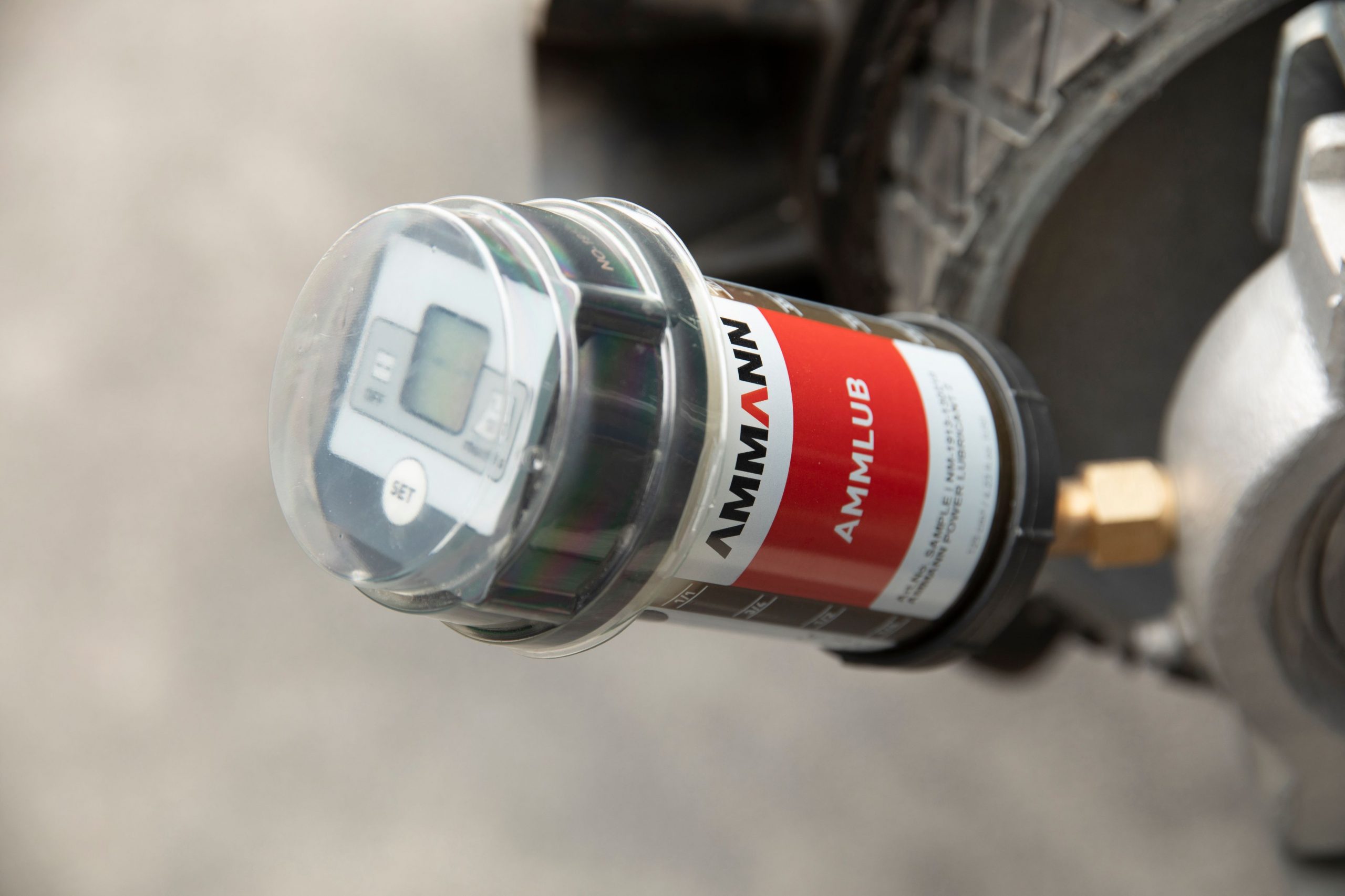
The Ammlub device from Ammann Group is mounted directly on the plant’s lubrication points.
All asphalt production businesses want to minimize the cost of ownership. The lower those expenses, the more competitive asphalt prices can be—and the higher profits can go. Ammann’s efforts to reduce asphalt operating expenses include Ammlub, which is Ammann’s automatic lubrication system, designed to provide three key benefits: longer plant life, reduced fuel costs and improved safety.
Traditional lubrication methods can be a struggle. They often require that technicians stretch and strain to reach extremely tight spaces—and that they fight dust, dirt and heat in the process. There also is the question of when to grease and how much grease to apply.
The labor-saving Ammlub system is mounted directly on the plant’s lubrication points. It automatically applies lubricants at scheduled intervals, ensuring that the process is done on time—every time. In addition, Ammlub eliminates downtime.
The lubricant applications can occur while the plant is running, enabling completion of the routine maintenance without a drop in productivity.
An immediate benefit is fuel savings, which can be reduced as much as 10 percent when all parts and components are working harmoniously.
With appropriate lubrication, those parts and components will also last longer, providing further savings. Because this system also locks out contaminants, plant life is extended, too.
Workplace safety is improved as well. Technicians no longer need to lug tools and fluids with them to access difficult-to-reach service points. These service points typically include all components along the process flow, starting with the cold feeder and ending with the discharge shoot.
For more information on the Ammlub product, contact simone.franz@ammann.com or visit www.ammann.com.
2. Astec Walks You Through Silo Maintenance Service
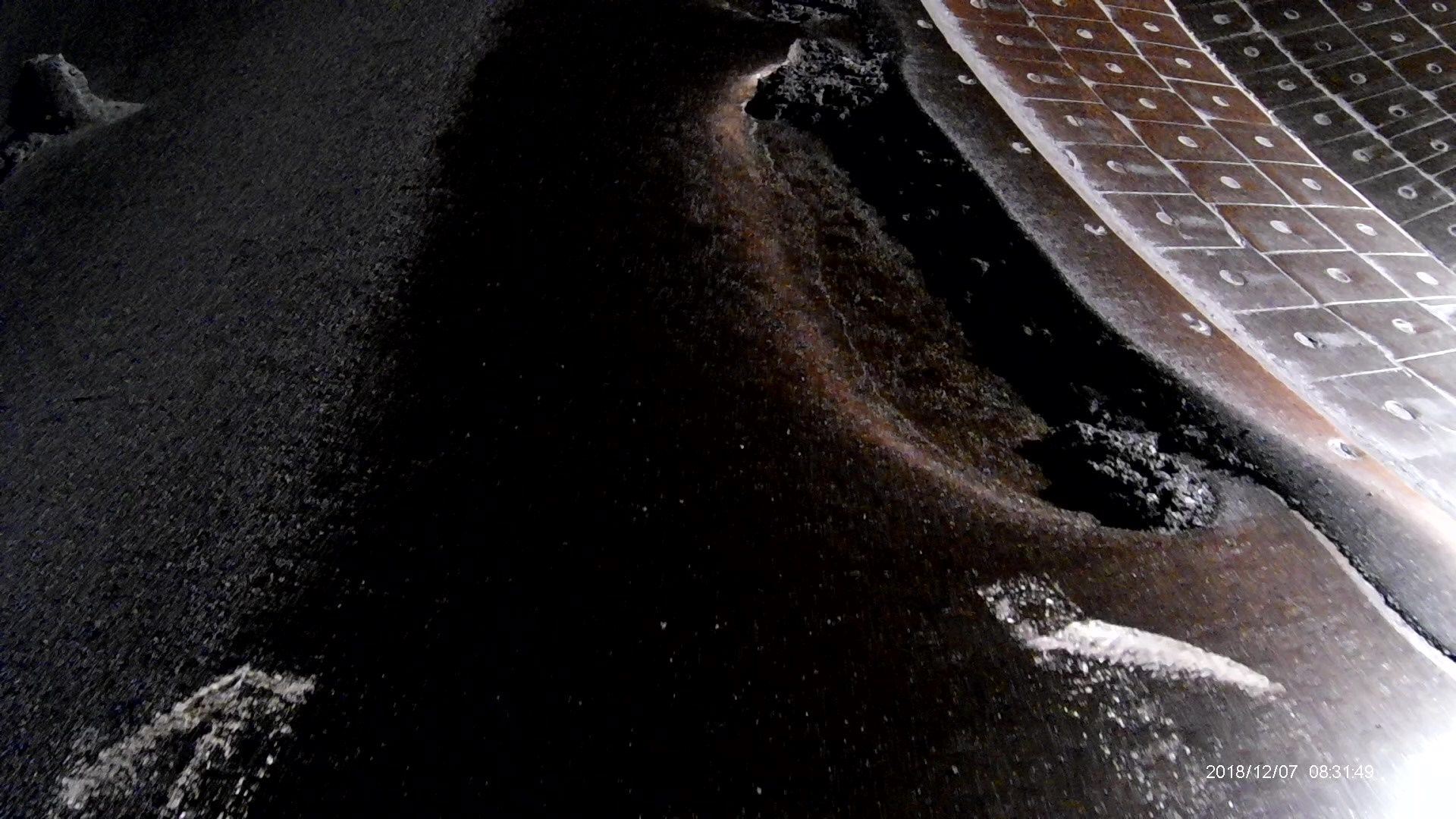
Inside this silo, a large hole is forming directly above the ceramic tiles. Areas like these were found along the entire circumference of the silo. Photo courtesy of Astec Industries
The team at Astec saw the need to make silo inspections safer and developed the SiloBot inspection device—a robot that is placed inside a silo by a trained inspection technician who then stays safely outside of the silo while performing a thorough inspection of the silo interior. A SiloBot inspection takes less than two hours to fully inspect all silo welds. With regular inspections, you can perform preventative maintenance that extends silo life.
Astec Engineering recommends having full silo inspections performed every two years, minimum. For high production facilities and silos that are 10 years or older, it is recommended to inspect annually.
Astec offers a recurring inspection plan for every 1-2 years that will allow us to provide the customer with comparative data. This data will help customers forecast wear in their silos so that preventative maintenance can be performed, giving them the ability to avoid spending unnecessary funds on more severe failures. Inspections can still be given on a one-time basis, as well.
Along with non-destructive thickness measurements, the SiloBot inspection device also checks for missing ceramic tiles, weld seam separation, damage to liner sections, holes in silo walls, batcher gate issues and other issues resulting in acute wear inside the silo.
One technician travels with two SiloBot inspection devices, software, a winch and mount, tools required for SiloBot device maintenance, and a truck with a mounted scissor lift in the bed. Customers are not required to rent manlifts.
The technician inserts the SiloBot through the mouth of the silo using a winch that is mounted on top of the silo (used as a safety tether and connected to the bot at all times) and the scissor lift mounted in the back of the truck. The incredibly strong natural magnets in the wheels allow the bot to traverse over ceramic tiles and onto the silo wall.
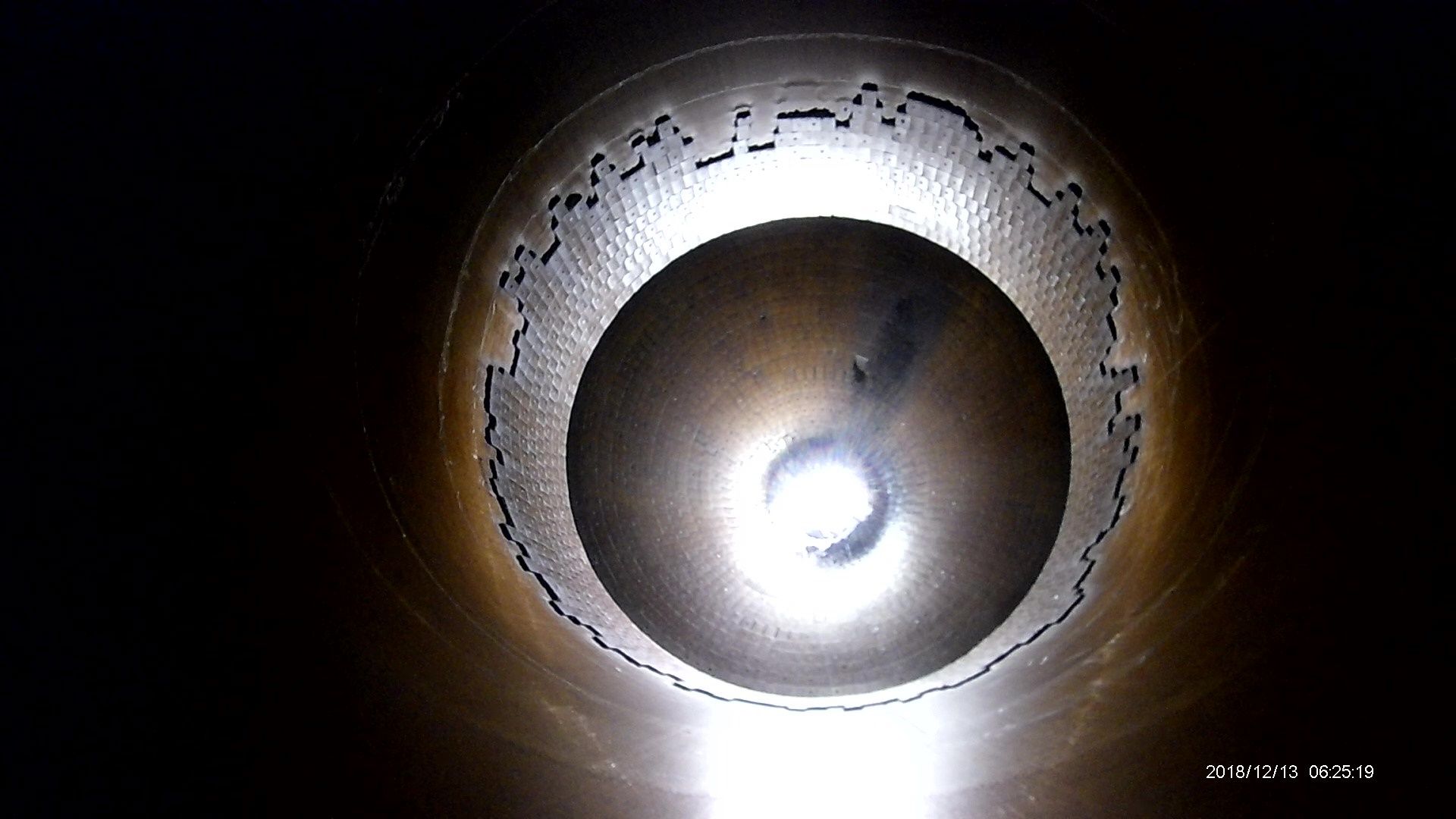
The large amount of missing ceramic tiles from the silo wall has allowed mix to wear the silo metal acutely in many areas. Multiple holes were found in this silo. Photo courtesy of Astec Industries
The SiloBot inspection device gathers data by utilizing a steel brush and motor to clean the silo wall prior to taking measurements with an ultrasonic thickness gauge. The data is then sent via a telemetry system linked to the technician’s laptop computer. This data is transmitted in real time, allowing the technician to view the results and fine tune the inspection as he goes.
Inspections range from 30 minutes to one hour, depending on the size and condition of the silo. The customer receives full 1080p HD video of each silo inspection on the day of inspection. The final report, delivered via e-mail in an average of 7-10 days, will include the raw data points, a graph that illustrates the location of these data points, and a written report with pictures that reference issues noted in the report. The report also features specific recommendations for repair.
SiloBot inspections can only be performed by a trained Astec technician due to the sophistication of the device and its components. Astec SiloBot Technician Alex Harrison said, “For customers with many plants, we devote ample time to get all of their inspections completed before moving to the next customer.”
If repairs are necessary, the repairs can be scheduled through the Astec Service Department or the customer can perform the repairs themselves.
To get information on the SiloBot inspection service, call on your regional Astec Parts or Capital Salesperson, or contact Alex Harrison directly at (423) 356-4791.
3. Brock Tells You When It’s Time to Change the Bags
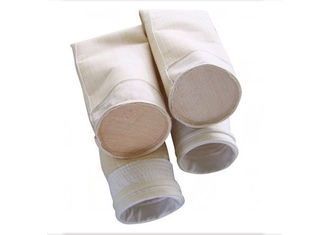
While Nomex bags are most common for HMA plant operations, the industry veterans at BROCK recommend an analysis of the plant’s overall operation and mix designs to assess the right bag for the application.
There are a lot of factors that affect the life of a baghouse bag and factors will likely be different at each plant site. Bag material, operation temperature, gas stream content, dust size, air-to-cloth ratio, cleaning effectiveness and bag fit all contribute to how long bags might last and when it is time to change them out.
The team at BROCK recommends inspecting baghouse bags at least once per year, but preferably two to three times per year. We especially recommend checking bags as frequently as reasonable when the operation uses—or changes to using—diesel or heavy fuel oil in their drying process, as the lack of atomization in the burning process can lead to oil in the dust and, eventually, on the baghouse bags.
Things we advise to look for, bag wise, are change in bag color, visible changes to the outside texture of the bags, holes in the bags, and shrinkage in the bags. One key data point operators can use to measure the overall effectiveness of the baghouse, along with the bags themselves, is to measure the differential pressure in the baghouse. It can be a leading indicator of bag and/or dust system issues. Of course, dust coming out of the baghouse stack is the easiest to see with the human eye as a key indicator of bag issues.
There have been several bag types introduced to the industry over the last 30 years and the technology behind them has made great strides in that time in an effort to keep up with the changes in mix designs. Changes in mix designs include increased RAP percentages, stone matrix asphalt, open graded mixes, asphalt rubber, glass, roofing shingles (RAS) and warm mix, among others. These all affect plant operating temperatures, dust types and dust volumes the baghouse experiences.
Bags that are commonly found in today’s hot-mix asphalt production world include 14 oz. Nomex, Nomex singed, micro denier, hydro entangled, and P84, for higher temperature applications. Nomex singed is the bag we have seen that fits the most common needs of plants; however, we do recommend an analysis of the plant’s overall operation and mixes produced to assess the right bag for an individual plant.
For more information about plant assessments, contact Travis Sneed, vice president of sales and operations, BROCK, at tsneed@brock.industries or visit www.brock.industries.
4. Butler-Justice Shares Blue-Smoke Elimination
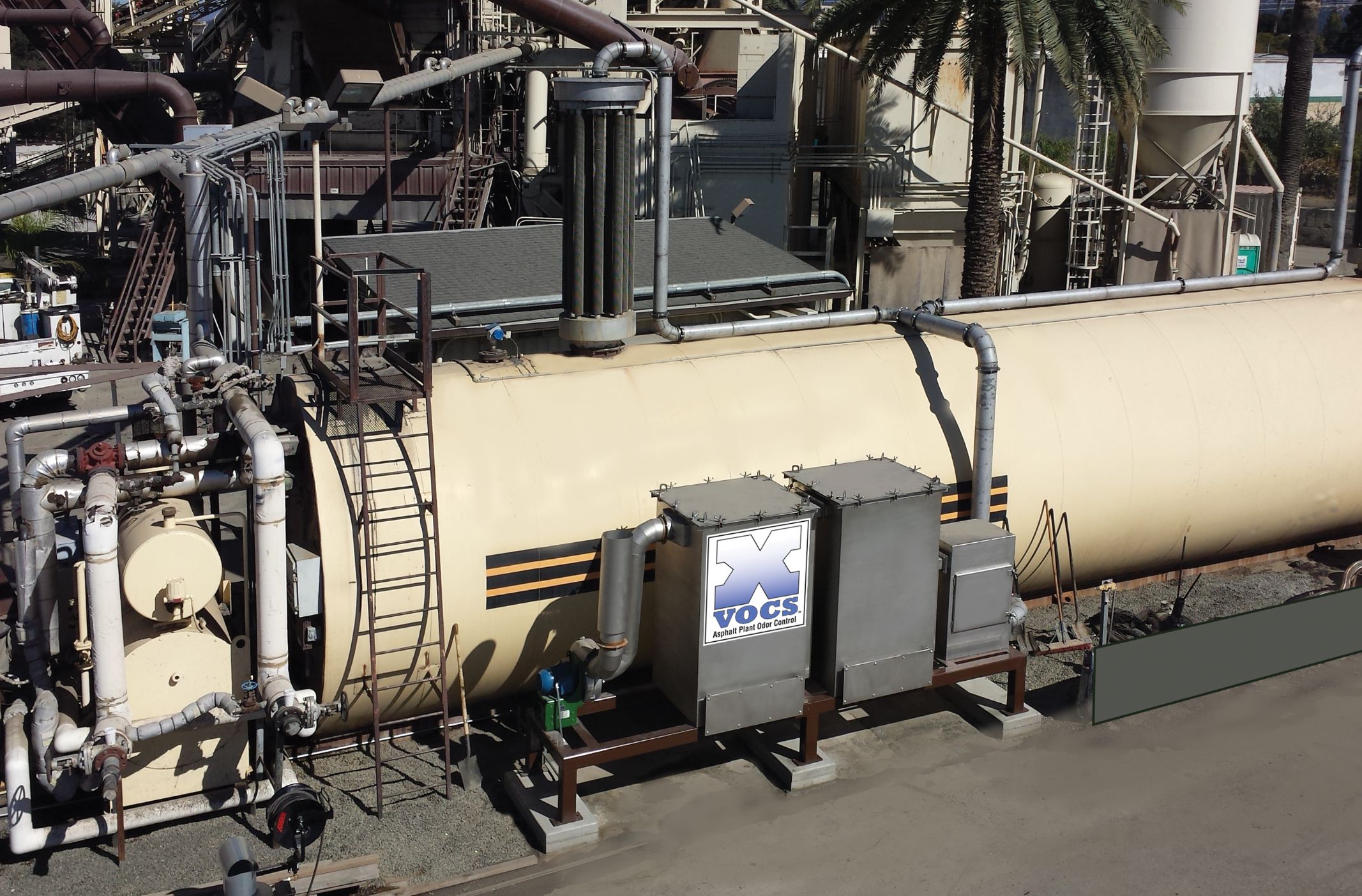
The X-VOCS system from Butler-Justice
As plants move toward the winter season, right now is an ideal time to assess any impacts from blue smoke and odors. Emissions from plants—both the classic, visible blue smoke and invisible volatile organic compounds (VOCs)—can cause challenges for producers, ranging from regulatory requirements to overt opposition from neighbors. Blue Smoke Control, a division of Butler-Justice Inc., Anaheim, California, offers two systems that, between them, is designed to eliminate both issues.
According to Mike Butler, president of Butler-Justice, “The addition of RAP, rubberized asphalt and polymer blends into asphalt mix designs has led to higher emissions due to higher mix temperatures.” His company now provides environmental control devices that can be installed at the asphalt plant to remove up to 99.9 percent of blue smoke, as well as the odors associated with asphalt production. Here’s how:
The Blue Smoke Control system captures blue smoke from emission points in the asphalt production process. Because blue smoke is essentially vaporized oil at high temperatures, Blue Smoke Control’s ducting system bleeds ambient (outside) air at key points. Seven stages of filters help to coalesce the tiny oil vapor droplets and aerosols into larger droplets that can be filtered out by the blue smoke collector. The oil droplets drain from the filters via gravity to a collecting sump.
In addition, the company offers its X-VOCS system, which features proprietary carbon absorption technology designed to filter and remove up to 99 percent of odors and VOCs, such as Hydrogen Sulfide (H2S), from the hot asphalt storage tanks. The X-VOCS incorporates a five-stage filtration system. In the first three stages, a series of filters remove more than 95 percent of targeted particulates down to 0.3 microns. In the final two stages, carbon filtration beds remove remaining odors and volatiles.
When the X-VOCS technology is coupled with the Blue Smoke Control system, emissions from HMA plants can be reduced to nearly zero, providing owners with the means to achieve the highest level of environmental stewardship.
Implementation of this technology has been proven to virtually end calls from nearby neighbors regarding odor and visual emissions. Both the Blue Smoke Control and X-VOCS systems can be incorporated into new plant designs, and they are also easily retrofitted into existing plant operations, with minimal modifications to the plant.
For more information on the X-VOCS system, contact mikeb@butlerjustice.com or visit www.bluesmokecontrol.com.
5. CWMF Offers Tips to Care for Your RAP System

Make sure seasonal maintenance includes a close look at your RAP system. Photo courtesy of CWMF
You can take preventative measures during the winter season to ensure a smooth process in the spring. Being proactive saves money and headaches when it’s time to start back up. Executing a preventative maintenance schedule for your RAP System in the winter, can lead to smooth sailing in the spring. Maintenance looks different for everyone, so here are some generalized tips to help reduce problems when it’s time to start running again.
The main components of a RAP system consist of the bins, collector belt, Tremor Shaker, Honey Badger hammermill, and scale conveyor. As a reference, the team at CWMF suggests looking through your manufacturer’s manual for specific maintenance recommendations. Additionally, you can follow these tips to help create your maintenance schedule.
Start by checking the obvious. Are your belt idlers functioning properly? Inspect the belt scraper, checking to see if the blades need replacement and if they’re set at the proper tension. Check for any tears in the belt splices and determine whether they should be repaired or replaced. Inspect all flashed or sealed-in areas to see if they are worn or need to be replaced. Check the shape of the screen cloth. Is it worn? Does it need replacement?
If you’re using a Honey Badger hammermill for oversized RAP, the consumables should be inspected, including hammers and liners. Look at wear life for both, and if replacement is needed. All drives should be checked for fluid levels in the reducers, and the shape of the v-belts. Make sure guards are intact.
The belt scale should be inspected and calibrated (go through the calibration process to verify proper function prior to startup). An accurate belt scale results in a quality mix.
Finally, check all electrical switches, i.e. limit switches and e-stop cable pulls for proper function.
This maintenance may seem small or tedious, but in the long run these are the things that tend to get overlooked, causing delays in the startup process resulting in costly downtime. Be sure to take time and follow your preventative maintenance schedule. Maintaining the proper functioning of your RAP system will help ensure your startup runs smooth like a freshly paved road.
For more information on the RAP system from CWMF, contact Travis Mick at sales@cwmfcorp.com or visit www.cwmfcorp.com.
6. Gencor Makes You an Energy Star
As Dennis Hunt, vice president of Gencor Industries, Orlando, Florida, often says with regard to anticipated performance of a hot mix asphalt (HMA) plant in response to design and operational changes, “it depends.” This very much applies to plant energy efficiency and fuel consumption. Per Hunt, there are numerous operating variables affecting energy efficiency and fuel consumption. These include: moisture content of the virgin and recycle feed stocks, counter-flow dryer virgin material veiling pattern, main exhaust temperature (waste heat), and use of warm-mix systems. While Gencor Industries works with its customers to optimize system performance, ultimately it is the responsibility of the end-user to run the plant in an energy-efficient manner.
One energy-efficiency measure that can, and is, integrated into HMA plants by the original equipment manufacturer (OEM) is insulation. Baghouses are insulated to prevent undesirable water condensation. Storage silos are insulated to keep the product mix at the required load-out temperature. Jacketed asphaltic cement piping can—and should—be insulated for both energy efficiency and worker safety purposes.
Another piece of equipment where insulation has become the norm rather than the exception is the counter-flow dryer.
The shell temperature of an uninsulated counter-flow dryer will range anywhere from less than 300⁰F at the ends (virgin aggregate feed breeching, and mix discharge to the finished product, or slat, conveyor) to perhaps more than 600⁰F in proximity to the combustion zone. Convective and radiant heat loss from an un-insulated dryer shell can be significant.
Insulation on a typical Gencor Industries counter-flow dryer covers approximately 75 percent of the surface area of the drum. The temperature of the insulation skin on a counter-flow drum will be in the range of 100 to 150⁰F. A substantial reduction in temperature that translates into, not only improved worker safety, but reduced energy requirements. A rule-of-thumb historically employed by Gencor is that insulating a dryer will reduce energy requirements by approximately 3 to 8 percent. Actual improvement in energy efficiency and associated payback period of the investment in insulation, of course, “depends.”
For more information, visit www.gencor.com or theasphaltpro.com/articles/how-to-be-an-energy-star/.
7. Haver & Boeker Helps Analyze Vibrations
Pulse vibration analysis technology can be used to evaluate vibrating screen performance. The team at Haver & Boecker Niagara, St. Catharines, Ontario, now partners with maintenance managers and plant managers to analyze screening processes, helping them meet production goals and overcome challenges with its Pulse Vibration Analysis Service.
Wilm Schulz, Haver & Boecker Niagara’s parts and service manager, explained: “Our Pulse Vibration Analysis Service offers more than just technology. We want to help our customers by serving as an extension of their maintenance teams, bringing the knowledge of an OEM to help support their operation.”
The service uses the company’s Pulse Vibration Analysis software to examine the health of a vibrating screen. Pulse detects irregularities that could translate into diminished performance, decreased efficiency, increased operating costs and imminent breakdown. This gives producers advanced notice so that their operation can plan preventative maintenance programs to avoid premature wear, downtime and additional expense.
The service program includes a complete vibrating screen inspection by a Haver & Boecker Niagara certified service technician. Following the inspection, customers receive a Pulse Diagnostic Report, which provides an analysis of their vibrating screen and detailed recommendations to prevent downtime. All Pulse Diagnostic Reports are stored in an online asset management system, giving customers access to a complete record of their vibrating screens’ service and performance histories.
For more information about Haver & Boecker Niagara’s Pulse Vibration Analysis Service Program, contact Kristen Randall at k.randall@haverniagara.ca or visit www.haverniagara.ca.
8. Kenco Advises for Longer Component Wear Life
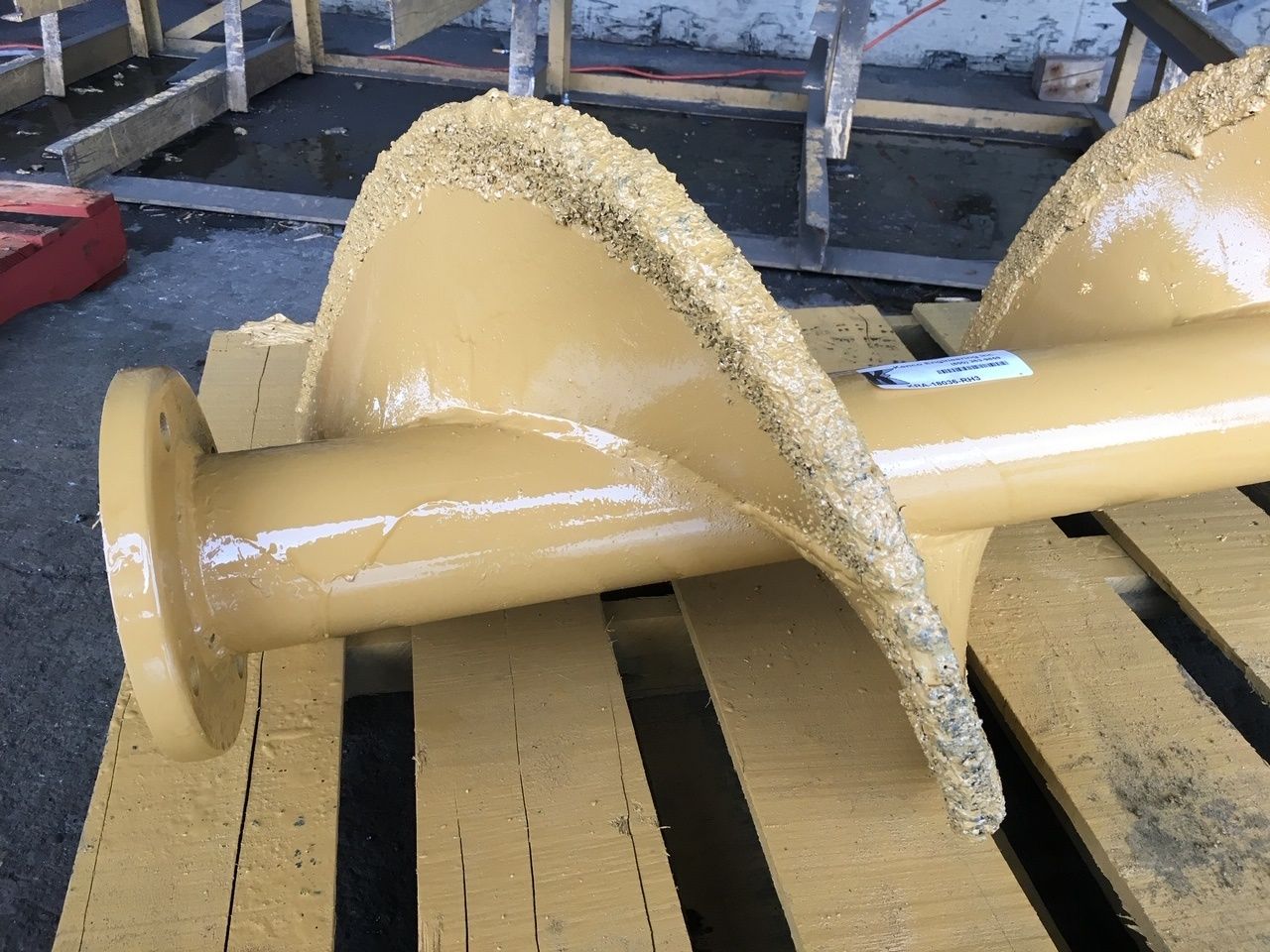
This photo shows the Kenco Engineering TCI steel strips installed on an auger.
Kenco Engineering Inc., Roseville, California, has been working to extend the life of augers for decades. At first, we developed the cast, bolt-on, auger shoe. This shoe incorporated a “lip” that wrapped over the outer edge of the auger to prevent the most common type of auger wear—diameter shrinkage.
In many cases, an auger running in an abrasive material will wear from the outer edge toward the shaft, thus reducing the diameter of the auger, more than on the face of the auger. This diameter shrinkage dramatically reduces efficiency of the auger and its ability to transfer material.
Over the last few years, however, we have learned that using our Tungsten Carbide Impregnation (TCI) process to protect augers can perform even better than the cast shoe around asphalt plants, especially the dust fines reject auger.
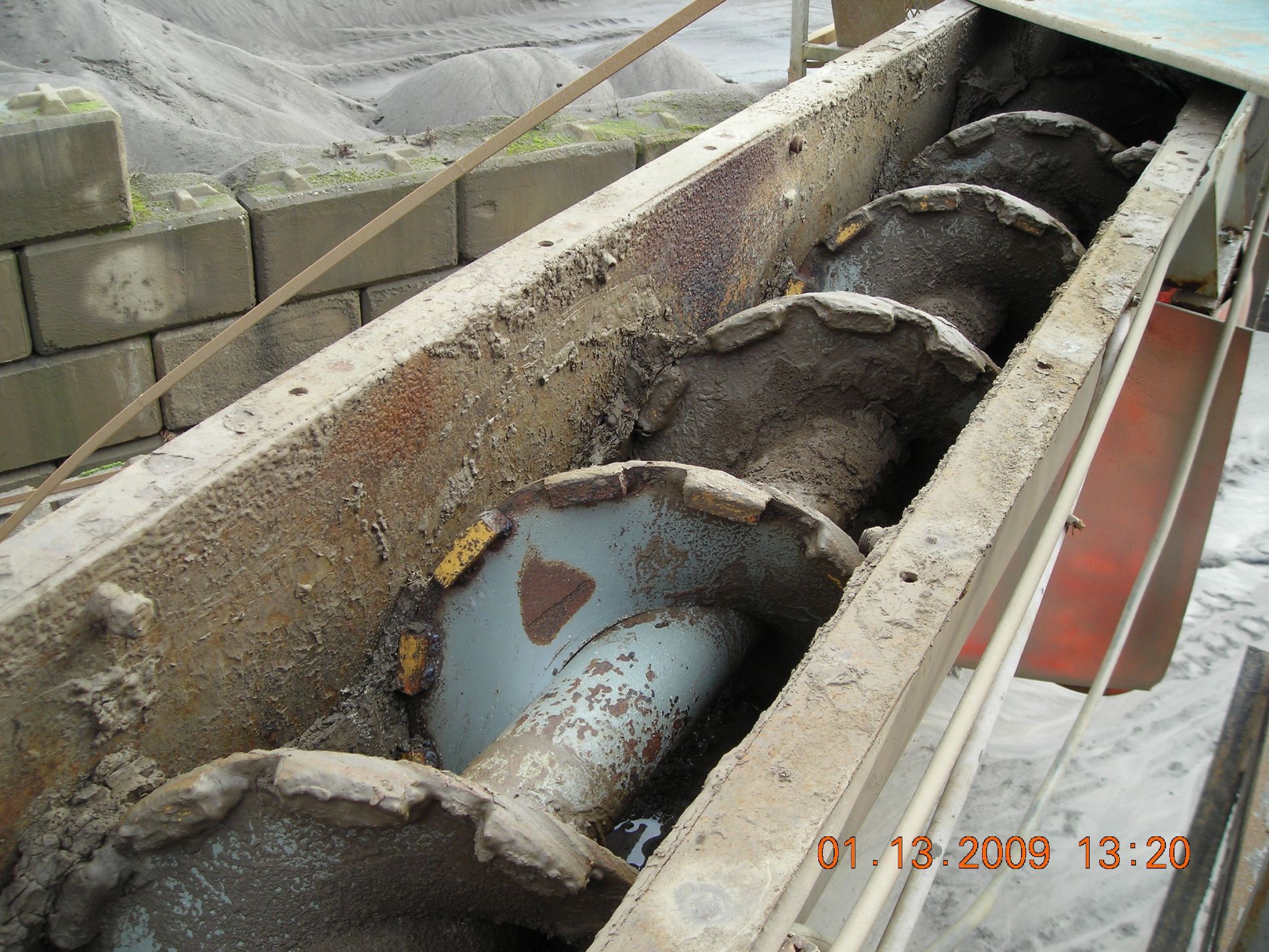
This photo shows a fines reject auger that, for many years, had averaged losing 1 inch of diameter per month. This photo was taken at five years of service with no loss of diameter during that period.
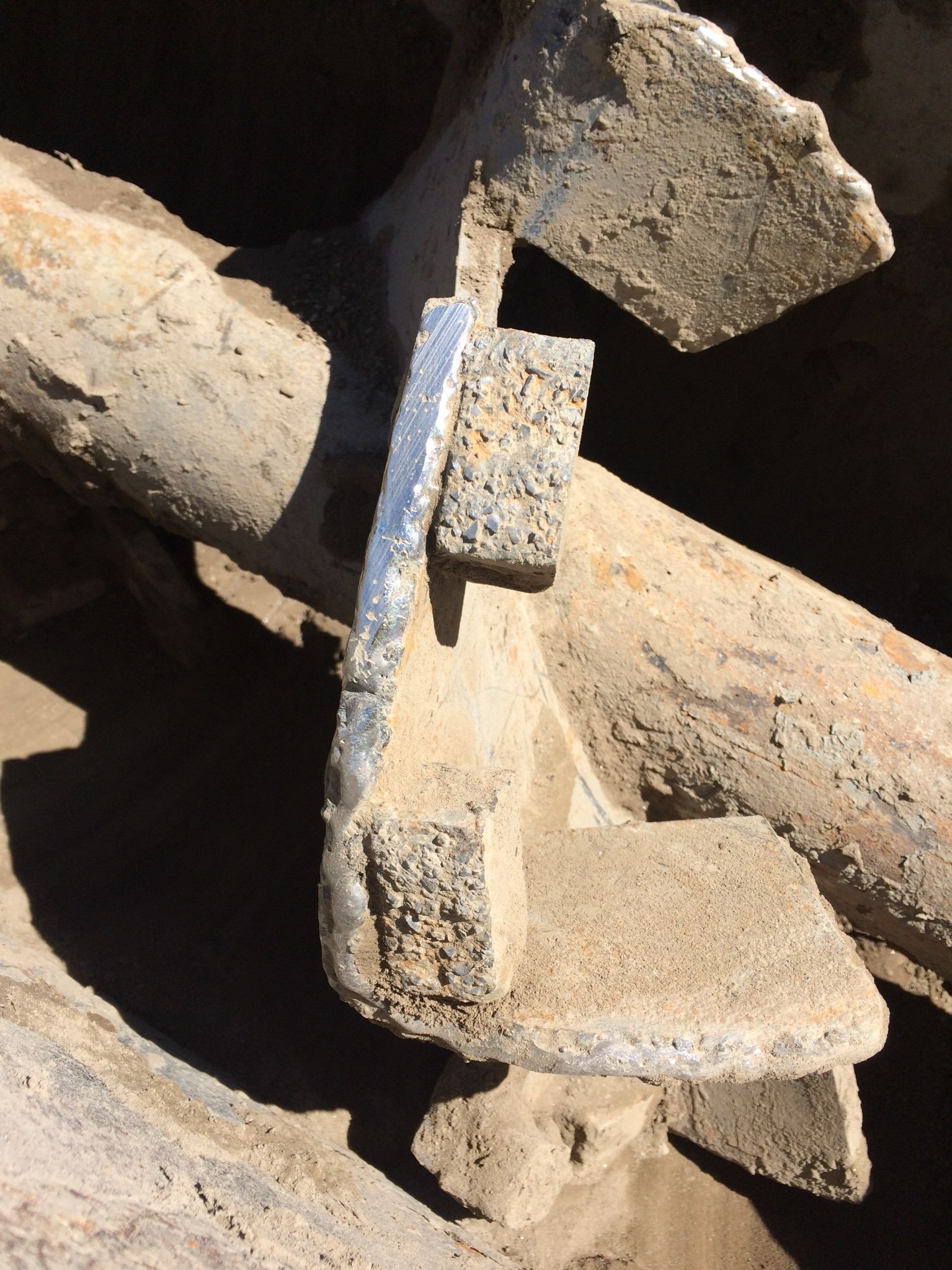
This next photo shows the use of our TCI bars on a “cut and folded” style dust auger. This customer had been changing out this auger half-way through each season. This photo was taken in the third season and the auger is still going strong.
The exceptional wear life of our TCI products comes from multiple factors. First is the hardness. At 90 Rockwell A, the hardness of Tungsten Carbide inherently makes it more wear resistant than even the hardest of AR steels. Next, with the rough texture of our TCI product, it traps material and helps create the cheapest of all wear products, material on material.
The versatility of our TCI product also enhances its usefulness around an asphalt plant. These two photos show the use of wear strips where Kenco impregnates our TCI into mild steel strips. These strips are then cut to size by the plant mechanic for installation on the auger or anywhere else wear is an issue. Due to their mild steel base, these strips can be welded with most common wire or electrodes for easy installation. As a final option, Kenco can manufacture a completely new auger with TCI protecting the outer radius as well as some portion of the face.
For more information on TCI protection, contact Brian Handshoe at brian@kencoengineering.com or visit www.kencoengineering.com.
9. Stansteel Tracks Your Trunnion Adjustment
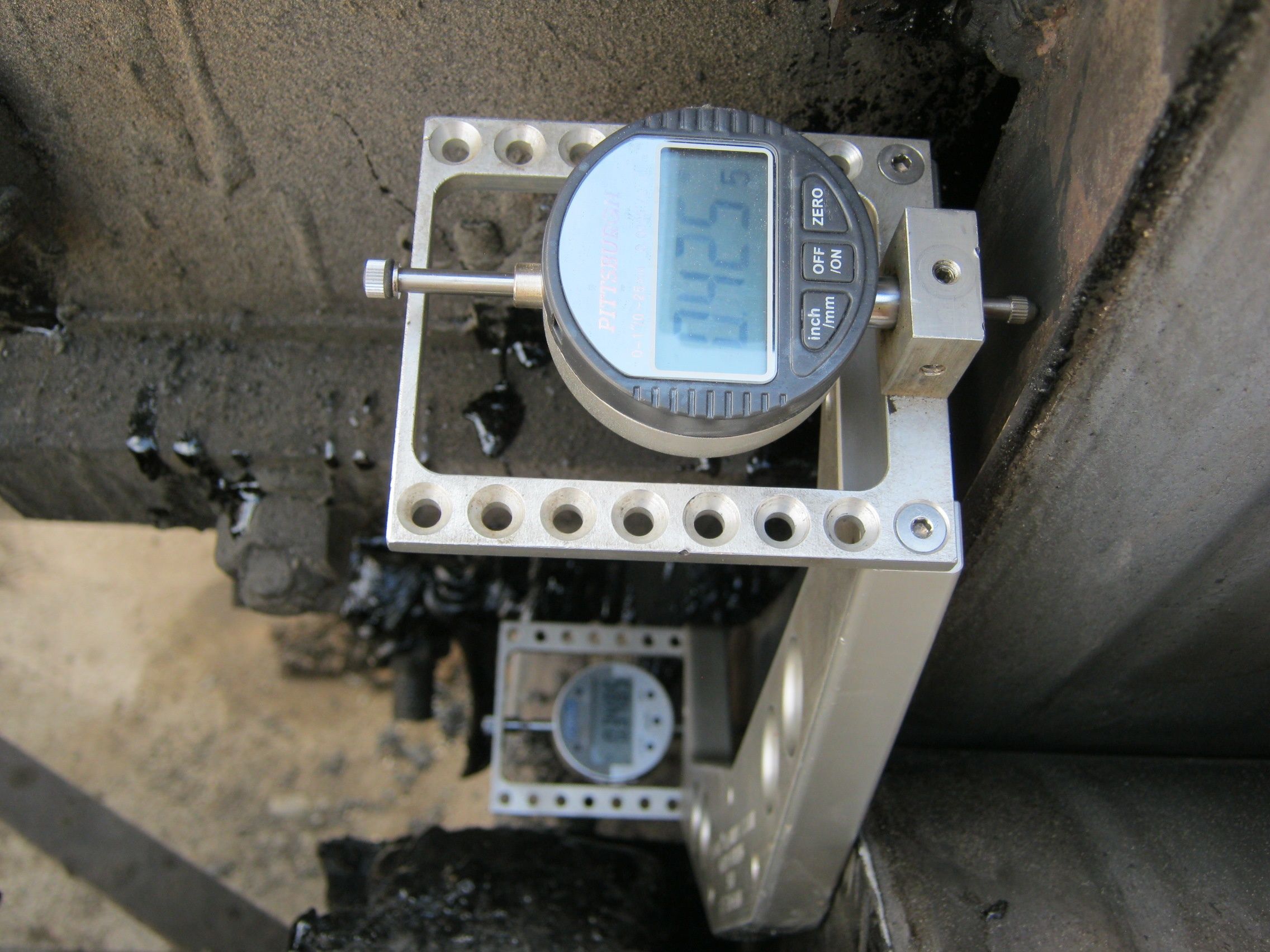
Depending on what stage of the adjustment process you’re in, you may want to see the numbers on the front and back displays be the same so the drum is not running uphill or downhill. Photo courtesy of Stansteel/Hotmix Parts & Service
Correctly adjusted trunnions reduce maintenance cost and plant downtime. Incorrectly adjusted trunnions cause a significant amount of abnormal wear and a multitude of premature failures that include broken thrust rollers, uneven tires and trunnions, and failed bearings. Precision adjusted trunnions maintain the plant’s tires and trunnions throughout the life of the drum and/or dryer.
There are many methods to adjusting trunnions. One common method is the use of a laser level and tape measure or other measuring device. This method is simple but not precise. While the laser beam is accurate, the width of the laser beam is not. Another attempt to keep trunnions properly aligned and skewed is to provide a measuring display on each trunnion base, but even this is not precise enough to prevent failures. The most precise and efficient method we’ve found for adjusting trunnions is our T-Trac Trunnion Alignment Tool by Stansteel and Hotmix Parts & Service. The T-Trac allows you to square the trunnions and tires within 100/1000th of an inch in precision.
In order to use the T-Trac correctly, lockout procedures need to be observed while working in contact with the equipment.
Once locked out and guards removed, the sides of the trunnions and tires need to be cleaned from dirt and grease.
The T-Trac consists of a magnetic base with dial indicators attached on each end facing the tire. Calibrate the dial indicators to the base with the included calibration blocks and the T-Trac is ready for use. Place the T-Trac on the side of the trunnion with both dial indicators on the side of the tire. Each of the four trunnions must be adjusted to the neutral position, meaning there is no longer uphill- or downhill-thrust. Adjust the trunnions to achieve a neutral (zero) delta between the two indicators, meaning that the trunnion is perfectly parallel with the tire.
The same method is performed for all four trunnions. Once all four trunnions are in a neutral thrust, the T-Trac can be used to skew each trunnion for the correct skew and thrust.
The trunnion adjustment methods of using a laser can take up to four to five hours to properly adjust your system. When using the T-Trac, precisely adjusting trunnions and tires can take as little as an hour and a half to complete the process for all four trunnions. The Stansteel & Hotmix Parts service technicians can visit your plant and demonstrate the T-Trac and adjust and skew your trunnions for you, ensuring precision accuracy of the adjustments.
For more information, visit stansteel.com.
